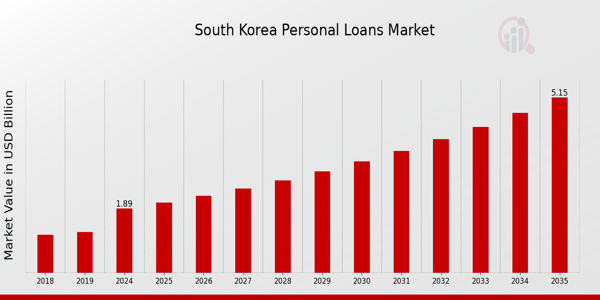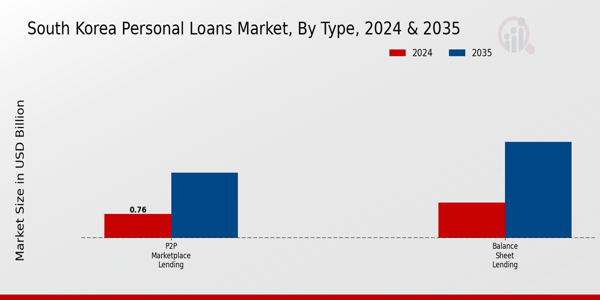South Korean Personal Loans Market Overview:
South Korean Personal Loans Market Size was estimated at 1.31 (USD Billion) in 2023.The South Korean Personal Loans Market is expected to grow from 1.89(USD Billion) in 2024 to 5.15 (USD Billion) by 2035. The South Korean Personal Loans Market CAGR (growth rate) is expected to be around 9.541% during the forecast period (2025 - 2035).
Key South Korean Personal Loans Market Trends Highlighted
A number of factors have contributed to the notable change in the personal loan industry in South Korea. The growing need for financial flexibility among people is one of the main factors propelling the market.
More South Koreans are looking for personal loans to cover costs associated with healthcare, house renovation, and education as a result of growing living expenses and urbanization. Additionally, the rise of digital lending services has been aided by the younger generation's desire for online borrowing options.
With fast approvals and customized loan solutions that appeal to a tech-savvy customer base, the emergence of fintech companies in South Korea has revolutionized traditional lending methods.
The market for personal loans in South Korea is also changing in terms of opportunities. Borrowers are become more knowledgeable about their options as financial literacy rises, which raises the demand for open lending procedures.
This change has given lenders the opportunity to create cutting-edge solutions that address particular needs, such as flexible repayment plans or short-term loans.
Organizations can benefit from this by improving the client experience and providing individualized services using data analytics. South Koreans are becoming more careful about debt, according to recent trends, which reflects a move toward responsible borrowing.
Additionally, the government has put policies in place to support consumer protection and financial stability, which has an impact on how lenders approach their marketing plans.
A growth in alternative loan choices has also been prompted by the COVID-19 epidemic, which has increased the significance of easily accessible financial solutions.
All things considered, the South Korean personal loan industry is adjusting to shifting consumer tastes while negotiating legal frameworks meant to protect borrowers and maintain market integrity.

Source: Primary Research, Secondary Research, MRFR Database and Analyst Review
South Korean Personal Loans Market Drivers
Rising Household Debt
In South Korea, the household debt level has been an area of concern, as it reached approximately 1.84 quadrillion won, representing an increase of over 5% year-on-year, according to the Bank of Korea.
This significant rise in household debt indicates a growing reliance on personal loans for managing expenses, leading to a boost in the South Korean Personal Loans Market. Notably, the government has acknowledged this trend and is adopting its policies to facilitate responsible lending practices while catering to citizens' needs for financial support.
With ongoing adjustments in regulatory frameworks, financial institutions are poised to navigate the increasing demand for personal loans within the market. Major banks like Kookmin Bank and Shinhan Bank are also ramping up their offerings to provide borrowers with competitive loan products, ensuring they can cater to this growing debt landscape.
Expansion of Digital Loan Platforms
The digital transformation in the financial sector has paved the way for the emergence of numerous online lending platforms in South Korea. Recent statistics show that online personal loans have grown significantly, contributing to about 20% of the market share, up from around 12% five years ago.
This trend is driven by the increasing number of tech-savvy consumers who prefer convenient, fast, and less bureaucratic lending solutions, with fintech companies like Toss and Viva Republica leading in this sector.
The South Korean Personal Loans Market is witnessing a surge in digital lending options, primarily powered by a shift towards mobile banking and enhancements in technology and user experience. Regulatory entities like the Financial Services Commission (FSC) are also working towards establishing clear guidelines, further legitimizing and supporting this digital lending growth.
Government Support for Financial Inclusion
The South Korean government has been actively promoting financial inclusion, which plays a crucial role in the growth of the South Korean Personal Loans Market. Various initiatives are being implemented to enhance access to credit for individuals from all socio-economic backgrounds.
For instance, the Financial Services Commission (FSC) has introduced policies to support micro-lending initiatives, allowing low-income individuals to qualify for small personal loans without excessive interest rates.
As reported, the government aims to provide financial relief to over 100,000 families annually through these initiatives. This focus on inclusivity not only drives market growth but also encourages responsible lending practices, making personal loans more accessible to those who may have traditionally struggled to secure funding.
South Korean Personal Loans Market Segment Insights:
Personal Loans Market Type Insights
The South Korean Personal Loans Market is experiencing notable growth, propelled by various factors, including consumer demand and technological advancements. Within this market, a prominent segment includes P2P Marketplace Lending, which has significantly transformed the lending landscape by connecting borrowers directly with individual or institutional lenders through online platforms.
This model not only streamlines the lending process but often provides borrowers with loans at competitive rates compared to traditional banks. The convenience and accessibility of P2P lending platforms appeal to a broad demographic, including younger consumers who are more tech-savvy and prefer digital interactions over traditional banking methods.
On the other hand, balance sheet lending remains a cornerstone of the personal loan landscape in South Korea, and it is primarily supported by established financial institutions. This type relies on the lender's balance sheet to fund loans, offering a more traditional approach to borrowing.
It plays a crucial role in catering to individuals seeking larger loan amounts or those with specific lending needs that may not be readily addressed through P2P platforms. Furthermore, Balance Sheet Lending often benefits from established lender reputation and regulatory compliance, which may appeal to risk-averse borrowers.
As these types of lending coexist in the market, they each address distinct consumer needs, creating a diversified lending environment that responds to a wide range of financial demands. The South Korean Personal Loans Market revenue is expected to reflect the growing preference for digital solutions alongside the trust and security offered by traditional lending channels.
Overall, the segmentation within the market is significant, with P2P Marketplace Lending and Balance Sheet Lending each embodying unique characteristics that contribute to the overall dynamics of consumer lending in South Korea.
The landscape continues to evolve with market trends intertwined with technological advancements, fostering opportunities for innovation while balancing the regulatory environment and consumer protection in lending practices.

Source: Primary Research, Secondary Research, MRFR Database and Analyst Review
Personal Loans Market Age Insights
The South Korean Personal Loans Market reflects distinct dynamics across various age groups, highlighting the diversity in borrowing patterns. Younger individuals, specifically those under 30, often exhibit a trend of seeking personal loans for education, starting businesses, or traveling, which drives their demand in the market.
Conversely, the 30-50 age bracket typically comprises individuals who leverage personal loans for major life events such as home purchases or family-related expenses, often leading to a substantial presence in overall borrowing activities.
Meanwhile, the segment of individuals over 50 generally focuses on retirement planning and health-related expenditures, suggesting a shift in borrowing motivations as they approach retirement. This segmentation within the South Korean Personal Loans Market emphasizes the changing financial needs across different life stages, showcasing opportunities for lenders to tailor their offerings.
Furthermore, the increase in digital lending platforms reflects a growing trend, especially among younger and middle-aged groups, as they seek convenience in accessing funds. Understanding these age-related nuances is critical for stakeholders looking to optimize their services and products to fit the varying needs within the South Korean Personal Loans Market landscape.
Personal Loans Market Marital Status Insights
In the South Korean Personal Loans Market, Marital Status segmentation plays a vital role in understanding consumer behavior and borrowing patterns. This market landscape reflects nuances among different marital statuses, notably distinguishing between Married, Single, and Others.
Married individuals typically showcase a strong tendency towards securing personal loans for family-oriented financial requirements, such as home improvements or children's education. This group often values stability, which contributes to their consistent demand for loans, as they seek to enhance their quality of life through financial planning.
Conversely, single individuals tend to exhibit a different borrowing approach, often favoring loans for personal goals like travel or investing in professional development. This demographic may display a higher propensity for impulsive lending, reflecting a more flexible lifestyle.
Additionally, the 'Others' segment, which includes unmarried couples or individuals in non-traditional relationships, is emerging as an important demographic, potentially tapping into the growing acceptance of diverse family structures in South Korea.
Overall, the South Korean Personal Loans Market segmentation based on marital status presents a comprehensive view of evolving financial needs and highlights the diverse opportunities for lenders aiming to cater to specific borrower profiles within the growing market landscape.
Personal Loans Market Employment Status Insights
The South Korean Personal Loans Market exhibits a diverse segmentation based on Employment Status, which encompasses categories such as Salaried and Business professionals.
This segmentation highlights a significant portion of potential borrowers, as a large segment of the South Korean population is engaged in formal employment or entrepreneurial activities. The Salaried group, comprising individuals with stable income from employment, tends to show higher creditworthiness, resulting in more favorable loan conditions and higher borrowing potential.
On the other hand, the Business segment reflects individuals operating their own enterprises, who often seek personal loans for various purposes, including business expansion or investment. The increasing trend of entrepreneurship in South Korea, supported by government initiatives to promote startup culture, enhances the relevance and demand for personal loans among this group.
As South Korea's economy continues to thrive, driven by youth engagement in varied professions, the Employment Status segment plays a crucial role in shaping the dynamics of the South Korean Personal Loans Market, catering to diverse financial needs and aspirations.
This segment's growth is influenced by evolving consumer behaviors, economic stability, and the rising reliance on credit, making it vital in the comprehensive landscape of personal loans within the region.
South Korean Personal Loans Market Key Players and Competitive Insights:
The South Korean Personal Loans Market showcases a highly competitive landscape characterized by a diverse array of financial institutions, each vying for market share by offering tailored loan products to meet varying consumer needs.
With a low-interest-rate environment and an increasing inclination towards borrowing for consumer goods and personal expenses, the market has experienced substantial growth. Digital transformation and customer-centric strategies are becoming paramount, allowing lenders to enhance their service efficiency and provide personalized experiences.
Furthermore, regulatory changes and competitive pressures encourage innovation in loan offerings, making the market dynamic and potentially profitable for institutions that can leverage technology effectively while maintaining risk management and compliance.
Korea Credit Card holds a significant position within the South Korean Personal Loans Market, leveraging its brand reputation and expansive consumer database. Its strengths lie in a robust range of financial products, including personal loans that cater to diverse segments, including young professionals and low-income borrowers.
The company is known for offering competitive interest rates and flexible repayment options tailored to meet individual financial situations. By integrating advanced technology into its lending processes, Korea Credit Card has improved customer experience through streamlined application procedures and quicker approvals.
The presence of a user-friendly online platform further bolsters its position, ensuring customers can easily navigate services and access their accounts on the go. This strong digital focus has allowed Korea Credit Card to enhance its customer retention and acquisition strategies.
NH Nonghyup Bank is a prominent player in the South Korean Personal Loans Market, recognized for its wide array of financial services tailored for personal and agricultural loans. Its key offerings include personal loans that cater to varying financial needs, like auto loans or home improvement loans.
NH Nonghyup Bank enjoys a robust market presence bolstered by a solid customer base and extensive branch network across South Korea, which facilitates direct consumer engagement. The bank's strengths lie in its commitment to personalized service, competitive rates, and efficient loan processing, making it an attractive option for borrowers.
Additionally, NH Nonghyup Bank has pursued strategic mergers and collaborations to enhance its product offerings and service delivery. Such initiatives not only strengthen its market position but also enhance the variety of products available to customers, ensuring that it remains competitive amidst evolving market dynamics.
Key Companies in the South Korean Personal Loans Market Include:
- Korea Credit Card
- NH Nonghyup Bank
- Shinhan Bank
- Citibank Korea
- Lotte Card
- Samsung Card
- Hana Bank
- Standard Chartered Bank Korea
- HSBC Korea
- KB Kookmin Bank
- KDB Bank
- LG Uplus
- Daegu Bank
- Busan Bank
- Woori Bank
South Korean Personal Loans Market Developments
The South Korean Personal Loans Market has witnessed notable developments recently, with various banks and institutions adapting to changes in consumer demand. NH Nonghyup Bank introduced new personal loan products in July 2023 to cater to young borrowers seeking lower interest rates.
Similarly, Shinhan Bank has been expanding its digital loan applications, thereby streamlining customer access since August 2023. In terms of mergers and acquisitions, Hana Bank announced plans to acquire a smaller peer in April 2023, focusing on expanding its market share in personal lending, with backing from reliable financial reports.
KB Kookmin Bank's valuation has seen significant growth, partly driven by their comprehensive online loan services, leading to increased consumer confidence in the market. Lotte Card's recent collaboration with LG Uplus in September 2023 aims to integrate financial services, further enhancing accessibility.
The ongoing global economic situation has reinforced these changes as banks strive to provide flexible loan solutions to support consumers amidst rising living costs. Overall, these advancements reveal a dynamic environment in the South Korean personal loans sector, responding to both technological shifts and customer needs.
South Korean Personal Loans Market Segmentation Insights
Personal Loans Market Type Outlook
- P2P Marketplace Lending
- Balance Sheet Lending
Personal Loans Market Age Outlook
- Less Than 30
- 30-50
- More Than 50
Personal Loans Market Marital Status Outlook
Personal Loans Market Employment Status Outlook
| Report Attribute/Metric Source: |
Details |
| MARKET SIZE 2018 |
1.31 (USD Billion) |
| MARKET SIZE 2024 |
1.89 (USD Billion) |
| MARKET SIZE 2035 |
5.15 (USD Billion) |
| COMPOUND ANNUAL GROWTH RATE (CAGR) |
9.541% (2025 - 2035) |
| REPORT COVERAGE |
Revenue Forecast, Competitive Landscape, Growth Factors, and Trends |
| BASE YEAR |
2024 |
| MARKET FORECAST PERIOD |
2025 - 2035 |
| HISTORICAL DATA |
2019 - 2024 |
| MARKET FORECAST UNITS |
USD Billion |
| KEY COMPANIES PROFILED |
Korea Credit Card, NH Nonghyup Bank, Shinhan Bank, Citibank Korea, Lotte Card, Samsung Card, Hana Bank, Standard Chartered Bank Korea, HSBC Korea, KB Kookmin Bank, KDB Bank, LG Uplus, Daegu Bank, Busan Bank, Woori Bank |
| SEGMENTS COVERED |
Type, Age, Marital Status, Employment Status |
| KEY MARKET OPPORTUNITIES |
Digital lending platforms expansion, Enhanced credit scoring methods, Tailored personal loan products, Growing demand for debt consolidation, Rise in e-commerce financing solutions |
| KEY MARKET DYNAMICS |
High credit demand, Strict regulatory environment, Rising interest rates, Increasing digitalization, Competitive lending landscape |
| COUNTRIES COVERED |
South Korea |
Frequently Asked Questions (FAQ) :
The South Korea Personal Loans Market is expected to be valued at 1.89 USD Billion in 2024.
By 2035, the South Korea Personal Loans Market is projected to reach a value of 5.15 USD Billion.
The market is expected to grow at a CAGR of 9.541 percent from 2025 to 2035.
The major types include P2P Marketplace Lending and Balance Sheet Lending.
P2P Marketplace Lending is expected to be valued at 2.08 USD Billion in 2035.
Balance Sheet Lending is anticipated to be valued at 1.13 USD Billion in 2024.
The market includes key players such as Korea Credit Card, NH Nonghyup Bank, and Shinhan Bank among others.
The value of Balance Sheet Lending is projected to reach 3.07 USD Billion by 2035.
Key growth drivers include increasing consumer spending and the rise of digital lending platforms.
Challenges in the market include regulatory compliance and increased competition among lenders.















